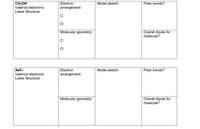
Concept explainers
1. For each molecule and ion below, indicate the total number of valence electrons. Based on that number of electrons, draw a valid Lewis structure.
2. Use VSEPR theory to determine the electron arrangement and the geometry of the molecule around the central atom(s). A table of geometries is attached.
3. Build the molecule using the molecular models provided in the lab. Sketch your model well enough to show the geometry. Include bond angles.
4. Using your understanding of electronegativity and its trends in the Periodic Table, determine if polar bonds exist in the molecule.
5. Using bond polarity and molecular shape, determine if the molecule has an overall dipole. If all the bonds are nonpolar, the molecule is nonpolar. If polar bonds are present, then consider the shape to determine if the molecule has an overall dipole


Trending nowThis is a popular solution!
Step by stepSolved in 3 steps with 2 images

- A. Write the number of valence electrons below each formula. No points if valence electrons are incorrect.B. Draw the Lewis structure. No additional points if Lewis structure is incorrect.C. Determine the molecular polarity. Write “P” for polar and “NP” for nonpolar. D. Determine the dominant attractive force. Write “L” for London force, “D-D” for dipole-dipole interaction and “H-B” for hydrogen bond. E. Predict the H2O solubility of each compound. Write “H” if it is high. Write “L” if it is low. Compound Lewis Structure Polar or Nonpolar DominantAF H2OSolubility H2S NH3 C2H6 OF2 C3H6Oarrow_forwardTag all the carbon atoms with pi bonds in this molecule. If there are none, please check the box below. H_O_C .. HC H | H There are none. Xarrow_forwardSolvearrow_forward
- * Question Complètion Status: QUESTION 1 Consider the following molecule. Name the geometry for the atom indicated by the arrow. OH HO. HO O linear O trigonal planar O tetrahedral O trigonal pyramid O bent QUESTION 2 Click Save and Submit to save and submit. Click Save All Answers to save all answers. MacBolarrow_forwardWhich statement A-D about VSEPR theory is not correct? Select one: a. The steric number has five values from 2 to 6. b. Statements A-D are all correct. c. In VSEPR theory, the shape or geometry of a molecule is determined by electron-electron repulsion. d. The steric number of a central atom is the sum of the number of bonds and lone pairs around the atom. e. The molecular shape or geometry can differ from the electron-pair geometry.arrow_forwardSuppose all the hydrogen atoms in this molecule are replaced by chlorine atoms: H. Draw a skeletal ("line") structure of the new molecule. Be sure you follow all the usual rules for drawing skeletal structures. c* Click and drag to start drawing a structure.arrow_forward
- Answer both images attachedarrow_forwardI'm not sure how to do this. Change the bond between the two carbon atoms in each molecule to a double or triple bond as needed to complete the structure If the bond should remain a single bond, then you do not need to do anything to the bond. Do not change any other bonds in the molecules.arrow_forward
 ChemistryChemistryISBN:9781305957404Author:Steven S. Zumdahl, Susan A. Zumdahl, Donald J. DeCostePublisher:Cengage Learning
ChemistryChemistryISBN:9781305957404Author:Steven S. Zumdahl, Susan A. Zumdahl, Donald J. DeCostePublisher:Cengage Learning ChemistryChemistryISBN:9781259911156Author:Raymond Chang Dr., Jason Overby ProfessorPublisher:McGraw-Hill Education
ChemistryChemistryISBN:9781259911156Author:Raymond Chang Dr., Jason Overby ProfessorPublisher:McGraw-Hill Education Principles of Instrumental AnalysisChemistryISBN:9781305577213Author:Douglas A. Skoog, F. James Holler, Stanley R. CrouchPublisher:Cengage Learning
Principles of Instrumental AnalysisChemistryISBN:9781305577213Author:Douglas A. Skoog, F. James Holler, Stanley R. CrouchPublisher:Cengage Learning Organic ChemistryChemistryISBN:9780078021558Author:Janice Gorzynski Smith Dr.Publisher:McGraw-Hill Education
Organic ChemistryChemistryISBN:9780078021558Author:Janice Gorzynski Smith Dr.Publisher:McGraw-Hill Education Chemistry: Principles and ReactionsChemistryISBN:9781305079373Author:William L. Masterton, Cecile N. HurleyPublisher:Cengage Learning
Chemistry: Principles and ReactionsChemistryISBN:9781305079373Author:William L. Masterton, Cecile N. HurleyPublisher:Cengage Learning Elementary Principles of Chemical Processes, Bind...ChemistryISBN:9781118431221Author:Richard M. Felder, Ronald W. Rousseau, Lisa G. BullardPublisher:WILEY
Elementary Principles of Chemical Processes, Bind...ChemistryISBN:9781118431221Author:Richard M. Felder, Ronald W. Rousseau, Lisa G. BullardPublisher:WILEY





